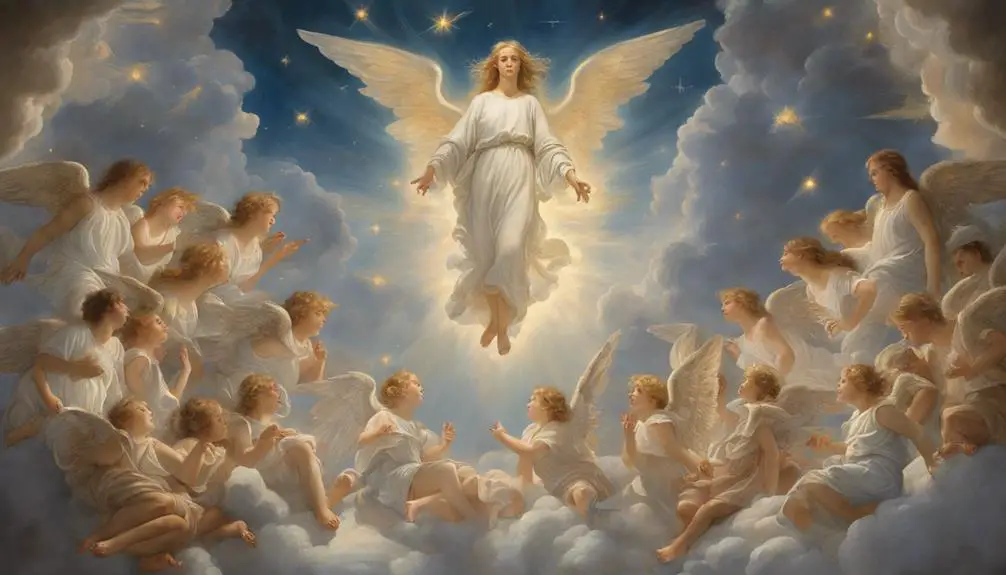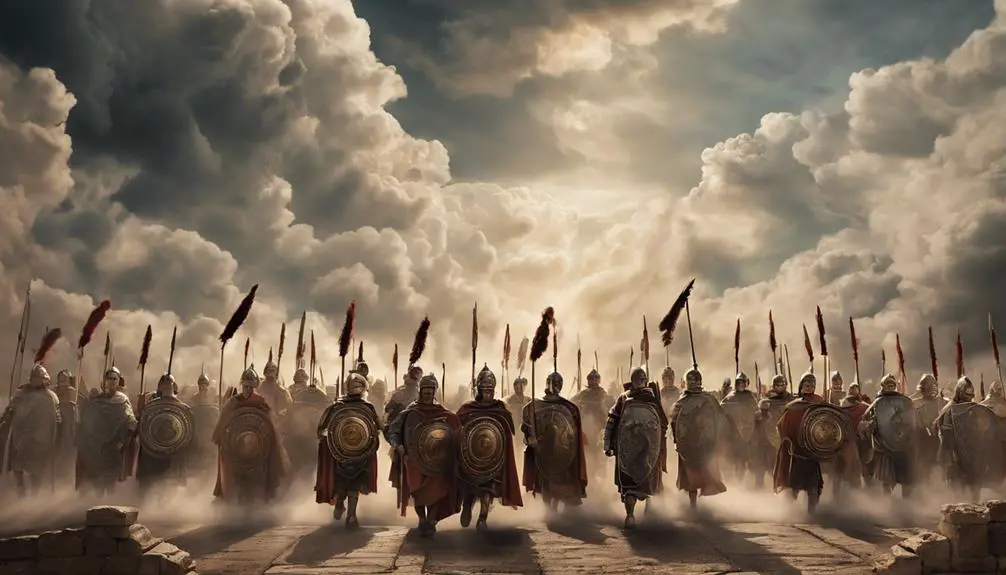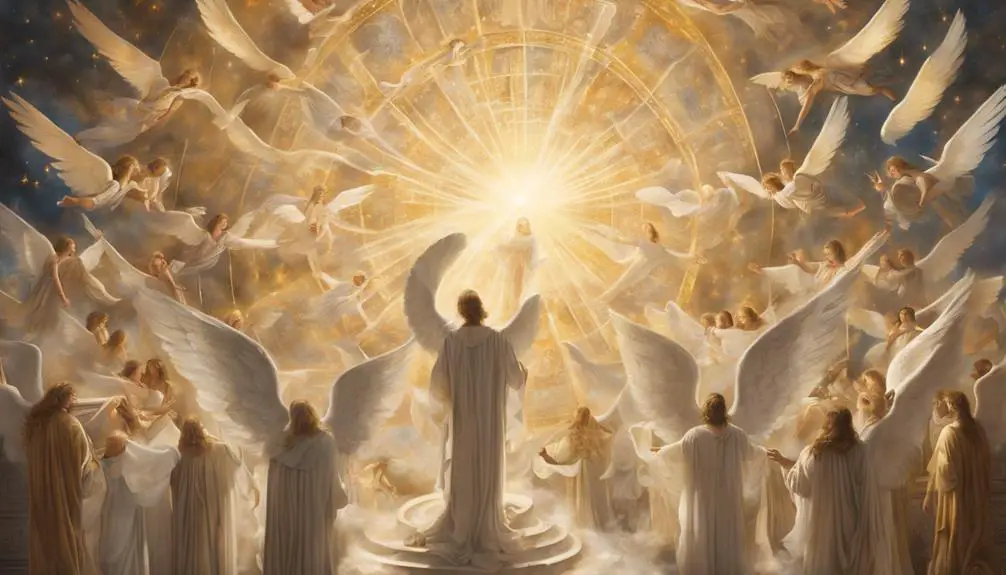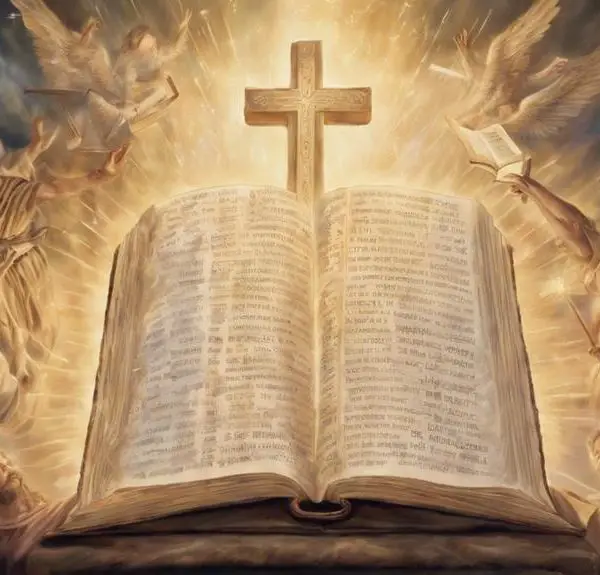Investigate the biblical mystery of a 'legion of angels', revealing historical context while leaving you yearning for more divine insight.

How Many Is a Legion of Angels in the Bible
Peeling back the layers of biblical text can often feel like unlocking a treasure chest of symbols and metaphors. One phrase that might have caught your attention is 'a legion of angels'. It's a phrase that's tucked away in the New Testament, but what does it really mean?
How many angels make up a legion? By exploring historical context, we can shed light on this intriguing question. However, you might find the answer is not as straightforward as you'd expect.
So, are you ready to unlock the mystery?
Key Takeaways
- A Legion typically signifies a vast multitude, often around 5,000 to 6,000, symbolizing the power and multitude of angelic beings.
- The Bible uses the term 'Legion' to represent the overwhelming presence and hierarchy of angels.
- The Gospel of Matthew, Revelation, and Luke reference 'Legion' to denote a large number of angelic hosts.
- Angelic legions symbolize the vast, unfathomable divine power, reflecting God's unlimited might and love.
Understanding the Term 'Legion

To grasp the biblical term 'Legion', you must first delve into its historical origins and contextual usage. The term Legion's origin is deeply rooted in Roman military history. Specifically, it referenced a significant division of the Roman army, typically consisting of 3,000 to 6,000 soldiers.
The term 'Legion', however, isn't merely a historical artifact. It's also a theological concept with profound implications. The use of 'Legion' in the Bible, particularly in the New Testament, connotes a vast multitude. It's employed to emphasize the overwhelming force or number of a group, whether it's demons, angels, or people.
Understanding Legion's implications requires you to consider its symbolic significance. It's more than a specific count; it represents a dramatic display of power and multitude. By using 'Legion', biblical authors effectively conveyed the sheer enormity of heavenly or demonic hosts, thereby emphasizing the spiritual warfare's magnitude.
Biblical References to Angelic Legions

Diving into biblical lore, you'll encounter several instances where 'Legion' is used to describe the vast numbers of angelic hosts, underscoring the immense power they wield in the spiritual realm. This term 'Legion' is indicative of the angelic hierarchy and the multitude of angelic appearances throughout the Scriptures.
To better illustrate this, let's consider the following:
- In the Gospel of Matthew (26:53), Jesus, during his arrest, mentions the ability to call on more than twelve legions of angels for assistance, signaling their ready availability and vast numbers in the angelic hierarchy.
- The Apostle John, in Revelation (5:11), describes a vision of myriad angels numbering 'ten thousand times ten thousand' around the throne of God, a number so vast it could indeed be described as a 'Legion.'
- In Luke (8:30), a demon self-identifies as 'Legion' due to the multitude of spirits within a possessed man, offering a striking contrast to the angelic legions serving God.
- The term 'Legion' is also used symbolically to represent innumerable angelic appearances, reinforcing the omnipresence and omnipotence of these celestial beings.
Mathematical Interpretation of a Legion

Now, let's decipher the numerical value of a 'Legion' as referred to in the Bible, giving you a clearer picture of the magnitude of angelic forces. The Legion's Numerical Value, within biblical context, isn't just a random figure, but rather, a carefully articulated representation of a vast multitude.
The term 'legion' in the Bible is used to denote a large number, typically associated with a military unit. Though the exact number may vary, it's generally accepted that a legion represents an assembly of about 6,000. This numerical interpretation of a legion helps us understand the grandeur and might of the Angelic Hierarchies mentioned in the Bible.
But the question arises, what's the significance of such a large number? Why would the Bible use such a high count to describe angelic forces? Well, it's to convey the sheer power and organization of these celestial beings. By associating them with a legion, it underscores their overwhelming presence and their ability to exert divine influence. This way, you can appreciate the vastness and the organization of these heavenly armies. This mathematical interpretation gives us a lens to understand the scale and the awe-inspiring nature of angelic legions.
Historical Context of a Roman Legion

Understanding the historical context of a Roman Legion can further clarify the biblical use of the term 'legion'. When you delve into the Roman organization and military strategies, you'll see the term 'legion' embodies a complex and highly disciplined system of power.
- Roman Hierarchy: The legion was the largest unit in the Roman army, typically composed of 5,000 to 6,000 soldiers. It was further divided into smaller units of cohorts, centuries, and maniples, each led by a different rank within the Roman hierarchy.
- Military Strategies: The Roman Legion wasn't merely a large group of soldiers, but a strategic powerhouse. They employed complex military strategies, tactical formations, and advanced engineering in warfare.
- Legionnaires' Role: Legionnaires, the backbone of the legion, weren't just warriors. They were engineers, architects, and craftspeople, contributing to the building of the Roman Empire.
- Legacy of the Legion: The Roman Legion, with its disciplined structure and sophisticated strategies, left a significant imprint on military history. Its influence extends into modern military organization and methodology.
This historical context illuminates the biblical use of 'legion', suggesting a large, organized, and powerful entity.
Symbolism and Significance of Angelic Legions

Exploring the symbolism and significance of angelic legions in the Bible reveals a powerful depiction of divine intervention and heavenly might. The number of angels in a legion, though uncertain, symbolizes an overwhelming force, underscoring the omnipotence of God and His divine messengers.
The angelic hierarchy in the Bible is of great importance. It's not just about their numbers; these heavenly beings are meticulously organized, reflecting the divine order in the spiritual realm. They aren't merely warriors but messengers delivering God's divine messages.
Every mention of an angelic legion signifies a critical moment of divine intervention, a turning point in the Biblical narrative, emphasizing their role as agents of God's will. The legion, in essence, represents the vast, unfathomable power of the divine.
It's crucial to note the symbolic weight of the angelic legion. It's a testament to God's unlimited power, a reminder of the divine capacity to intervene in human affairs. It also reflects the magnitude of God's love, that He'd deploy a legion of angels as protectors and messengers for humanity.
Understanding this symbolism deepens your appreciation of the Bible's narrative, offering a richer understanding of God's divine plan.
Frequently Asked Questions
What Are the Different Types of Angels Mentioned in the Bible?"
You'll find various types of angels in the Bible, each with distinct classifications and duties. Archangels, like Michael and Gabriel, are often depicted as God's messengers.
Seraphim and Cherubim are closer to God, praising and guarding His glory.
Then there are Thrones, Dominions, Virtues, Powers, Principalities, and Guardian Angels, each with specific angelic duties.
It's a fascinating study into Biblical angelology.
Are There Any Specific Angels Named in the Bible That Were Part of a Legion?"
In the Bible, no specific angels are named as being part of a legion. It doesn't provide details on 'Angel Legion Leadership' or the 'Legion Formation Process.'
Although the concept of a 'legion' of angels is mentioned, it's more a reference to a large number, not a specific structure or hierarchy. Therefore, you won't find named angels associated with a legion in the biblical text.
How Are Legions of Angels Depicted in Other Religious Texts?"
In your comparative theology study, you'll find a significant angel representation disparity in various religious texts. Unlike the Bible's depiction of legions of angels, other religions may not use this terminology or may portray them differently.
It's crucial to understand these variances as they reflect diverse cultural, theological, and historical perspectives, thus painting a more comprehensive picture of angelic figures in global religions.
What Is the Hierarchy Within an Angelic Legion According to Biblical Texts?"
When you delve into the Angelic Ranks Exploration, you'll find that the hierarchy within an angelic legion isn't explicitly defined in biblical texts. The Legion Significance Study suggests that legions are a vast multitude, yet the Bible doesn't assign a specific rank or structure to them.
Therefore, it's more about the collective power of the group than a hierarchy. Any hierarchical structures are conjecture based on non-canonical sources or interpretations.
Are There Any Modern Interpretations or References to Angelic Legions in Popular Culture?"
You'll find modern references to angelic legions in popular culture aplenty. Look at movies, books, or video games, and you'll see angelic legion symbolism used widely.
These references often depict legions as powerful, organized forces of good, reinforcing the biblical idea. But remember, interpretations vary, and it's always fascinating to see how different artists put their unique spin on such a timeless concept.
Conclusion
So, you've dug deep into the biblical and historical context of 'legion.' You now understand that a legion isn't a set number, but represents a large, unspecified multitude, often likened to a Roman legion of 3,000 to 6,000 soldiers.
This symbolic usage magnifies the awe-inspiring power and multitude of angelic legions, enhancing your comprehension of biblical text. Remember, it's not the exact count, but the grandeur and might of these angelic forces that matter.



Sign up